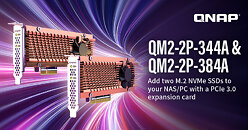- Joined
- Oct 9, 2007
- Messages
- 47,878 (7.38/day)
- Location
- Dublin, Ireland
| System Name | RBMK-1000 |
|---|---|
| Processor | AMD Ryzen 7 5700G |
| Motherboard | Gigabyte B550 AORUS Elite V2 |
| Cooling | DeepCool Gammax L240 V2 |
| Memory | 2x 16GB DDR4-3200 |
| Video Card(s) | Galax RTX 4070 Ti EX |
| Storage | Samsung 990 1TB |
| Display(s) | BenQ 1440p 60 Hz 27-inch |
| Case | Corsair Carbide 100R |
| Audio Device(s) | ASUS SupremeFX S1220A |
| Power Supply | Cooler Master MWE Gold 650W |
| Mouse | ASUS ROG Strix Impact |
| Keyboard | Gamdias Hermes E2 |
| Software | Windows 11 Pro |
QNAP Systems, Inc., a leading computing, networking, and storage solution innovator, introduced new QM2 PCIe Gen 3 expansion cards: the QM2-2P-344A and QM2-2P-384A. QM2 cards can be installed in compatible QNAP NAS or Windows /Linux PCs/workstations to add M.2 NVMe SSD slots (M.2 SSD sold separately) for boosting system performance and increasing storage capacity.
"The QM2-2P-344A and QM2-2P-384A are a budget-friendly expansion solution for both QNAP NAS and PC/workstations, providing flexible M.2 NVMe SSD configuration with easy-to-use tool-free installation," said Andy Chuang, Product Manager of QNAP, adding "Compared with SATA-based SSDs, the QM2's PCIe interface provides higher bandwidth to deliver faster transfer speed and data access."

The innovative QM2 cards feature M.2 SSD thermal sensors that allow real-time temperature monitoring, and an efficient cooling module (heatsink and smart fan) to minimize overheating and ensure high performance. They can be used for SSD caching for IOPS-demanding applications or enable tiered storage in QNAP NAS for optimized storage utilization.
The QM2-2P-344A and QM2-2P-384A also support Windows and Linux, and are ideal for creating NVMe SSD storage volumes for performance-demanding applications such as video editing.

For more information, visit the product pages of the QM2-2P-344A and QM2-2P-384A.
View at TechPowerUp Main Site
"The QM2-2P-344A and QM2-2P-384A are a budget-friendly expansion solution for both QNAP NAS and PC/workstations, providing flexible M.2 NVMe SSD configuration with easy-to-use tool-free installation," said Andy Chuang, Product Manager of QNAP, adding "Compared with SATA-based SSDs, the QM2's PCIe interface provides higher bandwidth to deliver faster transfer speed and data access."

The innovative QM2 cards feature M.2 SSD thermal sensors that allow real-time temperature monitoring, and an efficient cooling module (heatsink and smart fan) to minimize overheating and ensure high performance. They can be used for SSD caching for IOPS-demanding applications or enable tiered storage in QNAP NAS for optimized storage utilization.
The QM2-2P-344A and QM2-2P-384A also support Windows and Linux, and are ideal for creating NVMe SSD storage volumes for performance-demanding applications such as video editing.

For more information, visit the product pages of the QM2-2P-344A and QM2-2P-384A.
View at TechPowerUp Main Site



